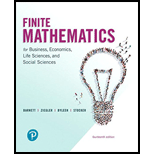
Concept explainers
Two fair (not weighted) dice are each numbered with a
(A) Find the probability distribution of
(B) Find the expected value of
Want to see the full answer?
Check out a sample textbook solution
Chapter 8 Solutions
Finite Mathematics for Business, Economics, Life Sciences and Social Sciences
Additional Math Textbook Solutions
A Problem Solving Approach To Mathematics For Elementary School Teachers (13th Edition)
A Survey of Mathematics with Applications (10th Edition) - Standalone book
Calculus for Business, Economics, Life Sciences, and Social Sciences (13th Edition)
Mathematical Ideas (13th Edition) - Standalone book
Using & Understanding Mathematics: A Quantitative Reasoning Approach (7th Edition)
Using and Understanding Mathematics: A Quantitative Reasoning Approach (6th Edition)
- Find the probability of each event. Drawing 5 orange cubes from a bowl containing 5 orange cubes and 1 beige cubesarrow_forwardFlexible Work Hours In a recent survey, people were asked whether they would prefer to work flexible hours----even when it meant slower career advancement----so they could spend more time with their families. The figure shows the results of the survey. What is the probability that three people chosen at random would prefer flexible work hours?arrow_forwardYou toss two six-sided dice. What is the probability that the total of the two dice is 5?arrow_forward
- Dividing a JackpotA game between two players consists of tossing a coin. Player A gets a point if the coin shows heads, and player B gets a point if it shows tails. The first player to get six points wins an 8,000 jackpot. As it happens, the police raid the place when player A has five points and B has three points. After everyone has calmed down, how should the jackpot be divided between the two players? In other words, what is the probability of A winning and that of B winning if the game were to continue? The French Mathematician Pascal and Fermat corresponded about this problem, and both came to the same correct calculations though by very different reasonings. Their friend Roberval disagreed with both of them. He argued that player A has probability 34 of winning, because the game can end in the four ways H, TH, TTH, TTT and in three of these, A wins. Robervals reasoning was wrong. a Continue the game from the point at which it was interrupted, using either a coin or a modeling program. Perform the experiment 80 or more times, and estimate the probability that player A wins. bCalculate the probability that player A wins. Compare with your estimate from part a.arrow_forwardQuality Control To control the quality of their product, the Bright-Light Company inspects three light bulbs out of each batch of ten bulbs manufactured. If a defective bulb is found, the batch is discarded. Suppose a batch contains two defective bulbs. What is the probability that the batch will be discarded?arrow_forward
 Holt Mcdougal Larson Pre-algebra: Student Edition...AlgebraISBN:9780547587776Author:HOLT MCDOUGALPublisher:HOLT MCDOUGAL
Holt Mcdougal Larson Pre-algebra: Student Edition...AlgebraISBN:9780547587776Author:HOLT MCDOUGALPublisher:HOLT MCDOUGAL Algebra & Trigonometry with Analytic GeometryAlgebraISBN:9781133382119Author:SwokowskiPublisher:Cengage
Algebra & Trigonometry with Analytic GeometryAlgebraISBN:9781133382119Author:SwokowskiPublisher:Cengage Algebra and Trigonometry (MindTap Course List)AlgebraISBN:9781305071742Author:James Stewart, Lothar Redlin, Saleem WatsonPublisher:Cengage Learning
Algebra and Trigonometry (MindTap Course List)AlgebraISBN:9781305071742Author:James Stewart, Lothar Redlin, Saleem WatsonPublisher:Cengage Learning College Algebra (MindTap Course List)AlgebraISBN:9781305652231Author:R. David Gustafson, Jeff HughesPublisher:Cengage Learning
College Algebra (MindTap Course List)AlgebraISBN:9781305652231Author:R. David Gustafson, Jeff HughesPublisher:Cengage Learning




